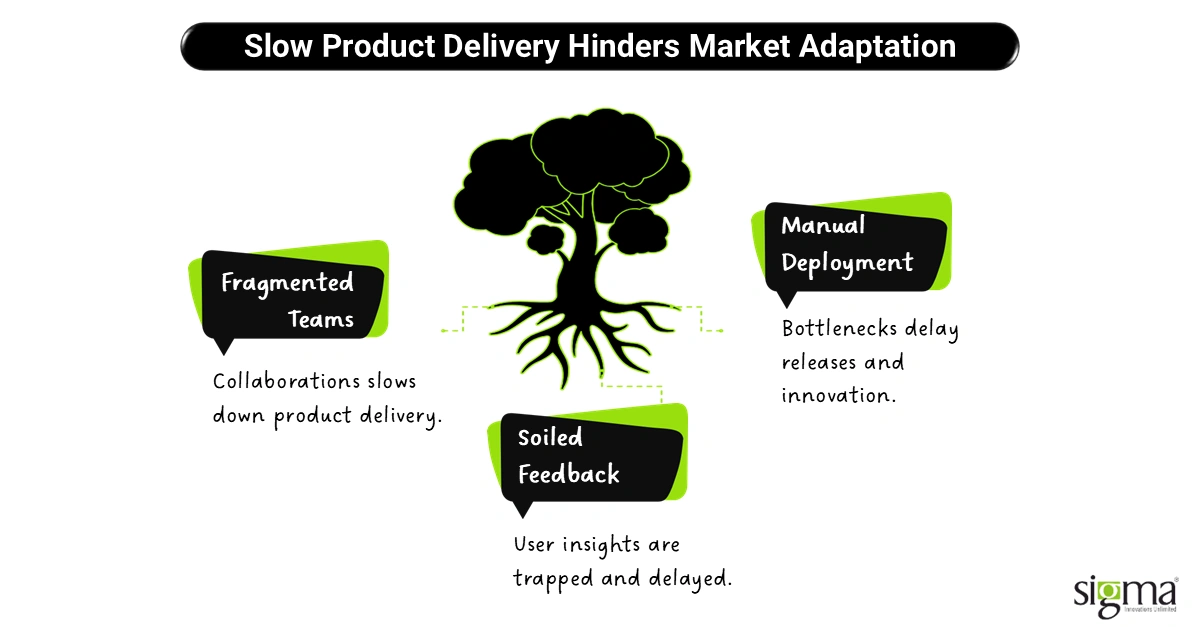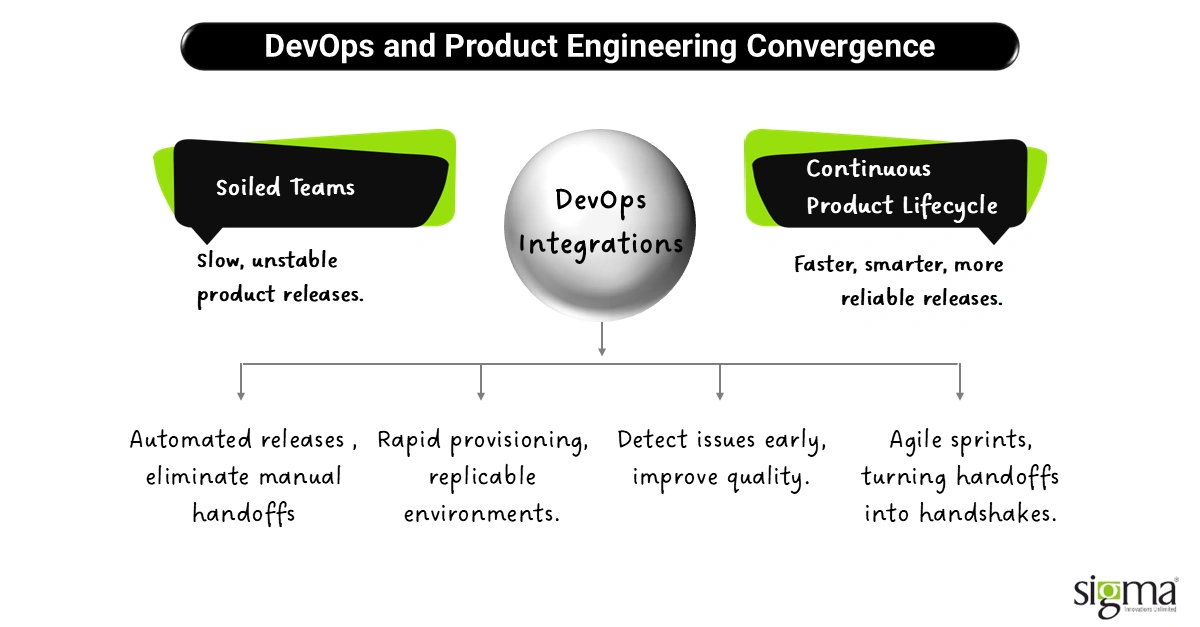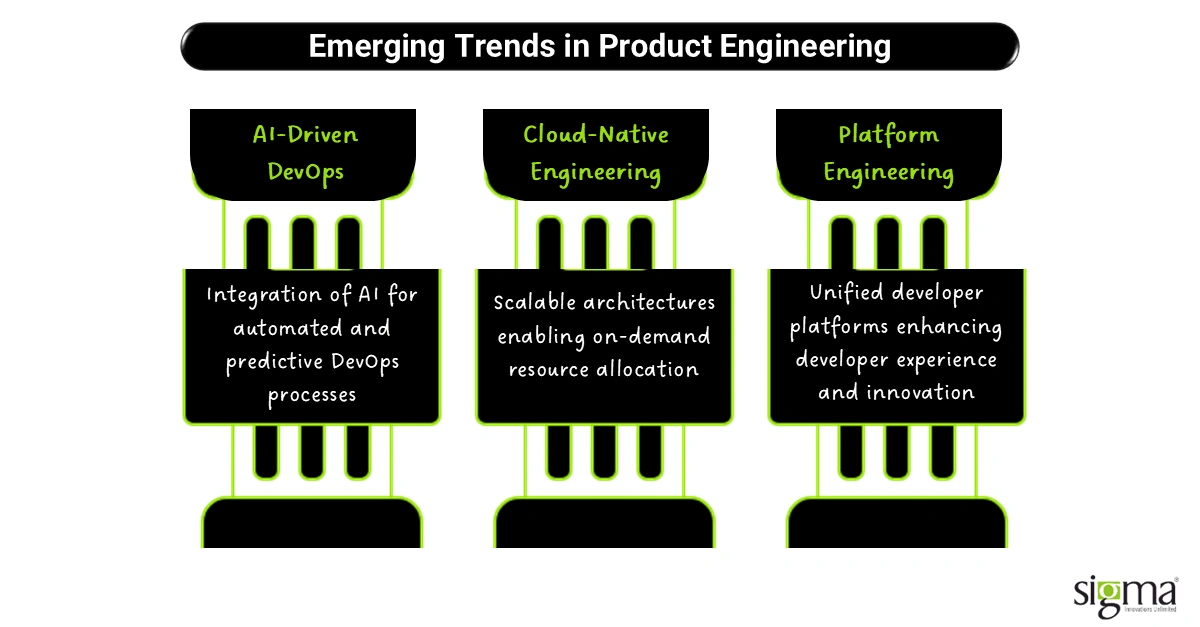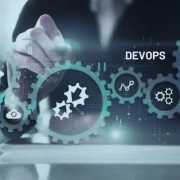Accelerating Time-to-Market Through DevOps-Enabled Product Engineering Services
Key Takeaways:
- From fire drills to frameworks: Stop chasing deadlines like a firefighter. With DevOps, your teams build with precision, not panic.
- From bottlenecks to breakthroughs: Ditch the manual grind; start the clockwork delivery driven by automation and collaboration.
- From chaos to cadence: When Dev and Ops move in rhythm, innovation doesn’t just happen faster, it happens continuously.
Here’s a cold truth: Many leaders still believe that faster product delivery means cutting corners or working longer hours. That’s not speed, that’s burnout. The “just work harder” mindset might have flown in the early 2000s, but in today’s hypercompetitive market, that’s a recipe for missed deadlines and frazzled teams.
- Myth: Speed equals chaos.
- Reality: Speed equals smart systems.
True speed isn’t about hustling harder; it’s about building smarter. And that’s exactly where DevOps-enabled product engineering services change the game. By integrating development and operations, DevOps as a Service replaces silos with synergy, making collaboration, automation, and continuous deployment part of the DNA of every software release.
“IMARC Group reports the global DevOps market is forecast to explode from $13.16 billion (2024) to $81.14 billion by 2033, with a 19.95% CAGR.”
In modern product engineering, DevOps practices bring together code, testing, deployment, and monitoring into one seamless pipeline, powered by continuous integration (CI) and continuous delivery (CD). The result? Fewer bottlenecks, faster feedback loops, and a market-ready product that evolves as fast as customer expectations.
At Sigma Infosolutions, we reject the patch-and-pray approach. As a product engineering services company, our approach relies on continuous innovation, where DevOps automation is not an afterthought but a foundation. We help businesses achieve sustainable velocity, where speed doesn’t break things, it builds them better.
Market Pressure and the Race to Deliver (The New Product Engineering Landscape)
The race to bring new digital products to market has never been this intense. Customers expect more features, flawless experiences, and faster releases all at once. According to SalesforceDevops, companies that adopt DevOps and leverage AI in their development processes are 30% more likely to rate themselves as highly effective.

Another study in the DORA’s State of DevOps Report found that companies adopting DevOps have shortened their product delivery cycles and achieved 50% higher software delivery performance compared to traditional methods, thanks to automation and real-time collaboration.
In this high-speed environment, product engineering services have become the backbone of digital transformation. The market no longer rewards those who move first, but those who adapt fastest. Continuous deployment and iteration aren’t luxuries; they’re survival tactics. Every delay in deployment can mean losing market share to a competitor who’s already testing their next update.
Yet, many technology leaders still face familiar roadblocks. Fragmented Dev and Ops teams slow down collaboration. Manual deployment pipelines become bottlenecks, forcing teams to spend more time fixing than innovating. Siloed testing and feedback loops keep valuable insights trapped, creating a lag between what users want and what gets delivered.
The old “throw it over the wall” development model is officially obsolete. In the new world of DevOps-enabled product engineering solutions, speed doesn’t come from rushing; it comes from removing friction. DevOps transformation is no longer an IT trend; it’s a business growth enabler that aligns technology with strategic outcomes.
Also Read: Software Product Design: Data Driven vs User Driven
What DevOps-Enabled Product Engineering Actually Does (Myth vs. Reality)
Let’s get one thing straight: DevOps isn’t a magic button you press and watch your delivery times shrink. It’s a mindset shift, a complete rewiring of how product teams build, test, and ship software. Too many still misunderstand it, so let’s bust a few myths.
| Myth | Reality |
| DevOps is just automation tools. | DevOps is a cultural and strategic framework that blends people, processes, and technology. Tools are just the tip of the iceberg. What really matters is how teams collaborate and continuously improve. |
| DevOps only helps developers. | It accelerates collaboration across QA, Ops, Security, and even Business teams because faster innovation needs shared ownership, not departmental walls. |
| DevOps increases risk due to faster releases. | With continuous testing, automated validation, and CI/CD pipelines, DevOps actually reduces production errors and downtime by catching issues earlier. |
| DevOps is expensive to implement. | It’s the opposite. While setup takes effort, DevOps automation and monitoring drastically cut long-term costs through faster recoveries and fewer manual interventions. |
So, what does DevOps in product engineering really deliver? It transforms software delivery from a sequence of steps into a living system where code, infrastructure, and testing move in sync. In a world where modern product engineering demands both agility and reliability, DevOps is the glue that keeps innovation from falling apart mid-sprint.
At Sigma Infosolutions, we don’t treat DevOps as an add-on; it’s the nervous system of our delivery engine. Every engagement, from planning and architecture to deployment and monitoring, is backed by DevOps as a Service to ensure end-to-end product engineering services that scale without friction.
We integrate DevOps automation, microservices architecture, and performance optimization through DevOps pipelines to help our clients launch faster and smarter. That’s not a luxury; it’s the new standard for enterprises that want to stay relevant in the future.
Why Time-to-Market Matters More Than Ever (The Business Imperative)
Here’s a stat worth pausing on. According to McKinsey’s comprehensive research, High-performing organizations that prioritize rapid Time-to-Market are rewarded with superior financial results, realizing a 35% uplift in revenue growth and a 10% increase in profit margins than their slower-moving peers. And it’s not just about bragging rights, it’s about survival.
In industries like Fintech and eCommerce, being even three weeks faster to launch can translate into millions in early revenue capture and customer retention. Faster deployment means quicker feedback loops, and quicker feedback means faster innovation. It’s a chain reaction of growth.
For leaders, the goal isn’t just speed, it’s sustainable speed. That’s where DevOps transformation plays its trump card. It replaces chaos with control and makes product engineering solutions a growth driver, not a cost center.
At Sigma, our clients don’t just ship faster—they ship smarter, continuously improving through metrics that matter: uptime, performance, and user experience. In today’s race to deliver, DevOps-enabled product engineering isn’t an advantage; it’s the baseline for staying in the game.
The DevOps–Product Engineering Convergence (How Integration Fuels Speed and Stability)
If product engineering is the art of building, then DevOps is the science of keeping that art in motion. The real magic happens when the two converge, creating a seamless ecosystem where innovation never hits a wall.

Product engineering focuses on designing scalable, customer-ready products that solve real business problems. DevOps, on the other hand, ensures that these products flow smoothly from development to deployment, with real-time feedback loops to keep improvement continuous. Together, they don’t just speed up releases; they build a continuous product lifecycle, where every iteration is smarter, faster, and more reliable than the last.
Key Enablers of This Integration
- Continuous Integration/Continuous Deployment (CI/CD): Automated pipelines ensure faster, safer releases by eliminating manual handoffs and deployment guesswork.
- Infrastructure as Code (IaC): Enables rapid provisioning and replicable environments that reduce configuration drift and downtime.
- Automated Testing and Monitoring: Detects, analyzes, and resolves issues early in the cycle, improving quality and confidence in every release.
- Cross-Functional Collaboration: Developers, QA, and operations work together through agile sprints, turning handoffs into handshakes.
This is where DevOps integration transforms from a buzzword into a measurable performance driver. The fusion of automation, infrastructure intelligence, and collaboration reduces time-to-market while enhancing system stability, a true win-win for modern enterprises.
At Sigma, this convergence isn’t theory, it’s practice. Our DevOps automation blueprint provides a modular framework that covers every stage: planning, CI/CD setup, automated testing, infrastructure automation, and observability dashboards. We deploy using AWS, Kubernetes, and Jenkins, ensuring agility without compromise.
This holistic model gives our clients the power to scale product delivery, improve performance, and achieve continuous innovation, all backed by data-driven insights and operational transparency. For any enterprise aiming to evolve from project-driven releases to product-driven excellence, Sigma’s product engineering services deliver the speed and stability that define digital leadership.
Sigma’s DevOps-Driven Acceleration Framework
Every transformation story begins with a bottleneck. For one of our enterprise clients, a fast-growing fintech platform, the pain points were all too familiar. Legacy systems, manual testing, and siloed teams were slowing down innovation just when market competition was heating up.
The Problem (Before Sigma)
- Legacy deployments are taking weeks instead of days, limiting their ability to respond to market feedback.
- Manual QA cycles that made every release a guessing game.
- Frequent communication breakdowns between Dev and Ops, causing last-minute scrambles and unexpected downtime.
They didn’t need more people; they needed smarter systems.
Sigma’s Approach (Solution)
We introduced our DevOps-driven product engineering framework, designed to bring automation, collaboration, and visibility to every stage of the lifecycle.
- Set up CI/CD pipelines to automate builds, testing, and deployment, ensuring continuous delivery.
- Integrated real-time monitoring and observability tools for proactive issue detection and faster incident resolution.
- Embedded agile workflows with feedback loops across teams to keep development aligned with business goals.
The Outcome (Impact)
The transformation was both cultural and operational:
- Release cycles reduced by 40–50%, improving responsiveness to customer needs.
- Deployment frequency doubled, with near-zero downtime incidents.
- Achieved faster MVP-to-market transitions, enabling earlier product validation and faster revenue generation.
This isn’t just about technology, it’s about culture. DevOps gives our clients the rhythm to deliver innovation at scale. From re-architecting monoliths to modular UIs, Sigma extends this agility to the user experience layer through modern front-end engineering with ReactJS development services, ensuring that every product iteration delivers both speed and visual performance.
DevOps as a Service in the USA, Sigma empowers enterprises to modernize without disruption. We help clients bridge the gap between ambition and execution, turning slow-moving systems into fast-learning organizations through our product engineering services that blend automation, agility, and accountability.
Also Read: Why the C-Suite Can’t Ignore Microservices-Based App Development Services
The Measurable ROI of DevOps-Enabled Product Engineering
In the digital world, speed is currency, and DevOps ensures you’re never short on it. For modern enterprises, the ROI of DevOps-enabled product engineering isn’t measured in theory; it’s visible in every sprint, every release, and every uptime metric that keeps the business running smoothly.
Key Metrics That Matter
- Faster release cycles, up to 60% reduction in deployment timelines through automation and continuous integration.
- Improved deployment success rate, with fewer rollbacks and smoother releases thanks to proactive monitoring and automated QA.
- Enhanced developer productivity, as manual tasks are replaced by intelligent pipelines and collaborative feedback systems.
- Reduced downtime and maintenance overhead, freeing engineering teams to focus on innovation rather than firefighting.
Translating Tech Wins into Business Value
Here’s what these metrics mean in plain business terms:
- Every hour saved in deployment = hours gained in innovation. That’s more time to ideate, test, and roll out new features before the competition catches up.
- Every bug prevented = dollars saved in recovery costs. Continuous testing and early detection eliminate expensive post-production fixes.
- Every automated process = reduced oFintech perational cost. DevOps transforms your tech stack from a cost center into a profit accelerator.
In industries like Fintech and eCommerce, where time-to-market defines who leads and who lags, these gains aren’t just operational; they’re strategic. Companies leveraging DevOps automation and product engineering solutions in the USA are reporting stronger scalability, faster innovation loops, and measurable upticks in customer satisfaction.
At Sigma, we’ve seen these results firsthand. Our end-to-end product engineering services help enterprises translate DevOps maturity into measurable ROI, driving growth, resilience, and competitive advantage at every release.
The Future of Product Engineering with DevOps, AI, and Cloud
The next chapter of product engineering is being written at the intersection of DevOps, AI, and Cloud. Together, these forces are redefining how digital products are designed, built, and delivered, transforming development from a linear process into a living, adaptive ecosystem.
Emerging Trends Shaping the Future

- AI-Driven DevOps (AIOps): The integration of predictive analytics and machine learning into CI/CD pipelines is changing the DevOps game. Imagine systems that self-heal, detect performance anomalies before they happen, and automatically optimize build workflows, reducing human intervention and boosting reliability.
- Cloud-Native Product Engineering for Scalability: As businesses expand across platforms and geographies, cloud-native architectures are becoming the backbone of modern scalability. They enable faster provisioning, microservices-based agility, and elastic infrastructure, making “scale on demand” a tangible reality, not just a buzzword.
- Platform Engineering – The Next Evolution of DevOps: The rise of platform engineering marks a shift from DevOps as a practice to DevOps as a product. Unified developer platforms, integrated with automated workflows and observability tools, are simplifying complexity and improving developer experience, accelerating innovation across the enterprise.
Sigma’s Vision (Smarter, Faster, and More Reliable Product Delivery)
At Sigma, we believe the future belongs to organizations that can build, test, and deploy at the speed of thought. By fusing DevOps automation, AI-driven insights, and cloud-native engineering, we empower clients to deliver smarter, faster, and more reliable digital products.
Our vision is not just about adopting new tools; it’s about creating a continuous delivery ecosystem that learns, adapts, and scales with business ambition. With Sigma’s product engineering services in the USA, enterprises can move beyond traditional software delivery to embrace a future where innovation is continuous, not episodic.
In the race to market, speed is no longer optional. DevOps is how you stay in the race.
Final Thoughts
At its core, DevOps isn’t about tools or scripts; it’s about transforming how teams deliver value. It bridges silos, accelerates innovation, and makes “faster to market” a repeatable outcome, not a lucky break.
If your organization is ready to evolve from long deployment cycles to continuous innovation, it’s time to take the next step. Sigma Infosolutions blends DevOps culture, automation, and cloud-native engineering to help businesses build products that move at market speed, with stability and confidence.


